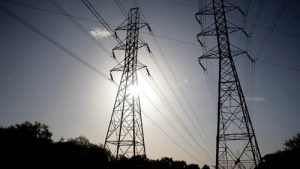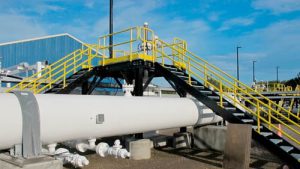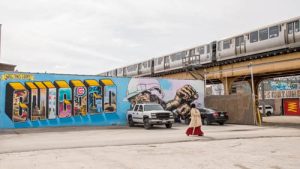Recent News
10 Times as Much of This Toxic Pesticide Could End Up on Your Tomatoes and Celery Under a New EPA Proposal

Photo illustration by Lauren Joseph/ProPublica. Source images by Cavan Images/Getty and Sirisak Boakaew/Getty.
Against the guidance of scientific advisory panels, the EPA is relying on industry-backed tests to relax regulations on acephate, which has been linked to neurodevelopmental disorders. “It’s exactly what we recommended against,” one panelist said.
When you bite into a piece of celery, there’s a fair chance that it will be coated with a thin film of a toxic pesticide called acephate.
The bug killer — also used on tomatoes, cranberries, Brussels sprouts and other fruits and vegetables — belongs to a class of compounds linked to autism, hyperactivity and reduced scores on intelligence tests in children.
But rather than banning the pesticide, as the European Union did more than 20 years ago, the U.S. Environmental Protection Agency recently proposed easing restrictions on acephate.
The federal agency’s assessment lays out a plan that would allow 10 times more acephate on food than is acceptable under the current limits. The proposal was based in large part on the results of a new battery of tests that are performed on disembodied cells rather than whole lab animals. After exposing groups of cells to the pesticide, the agency found “little to no evidence” that acephate and a chemical created when it breaks down in the body harm the developing brain, according to an August 2023 EPA document. 04-24-24
Biden’s ‘Solar for All’ Awards $7B to Bring Affordable Energy to Low-income Families
The program is designed to reduce greenhouse emissions and energy inequity.
 Clean energy, like so many commodities in this country, is neither distributed evenly nor equally. Disadvantaged communities have far fewer solar panels arrayed across their rooftops than areas with higher incomes. The federal government just took a major step toward crossing that chasm.
Clean energy, like so many commodities in this country, is neither distributed evenly nor equally. Disadvantaged communities have far fewer solar panels arrayed across their rooftops than areas with higher incomes. The federal government just took a major step toward crossing that chasm.
On Monday, President Joe Biden announced the 60 organizations that, under the administration’s Solar for All program, will receive a combined $7 billion in grants to bring residential solar into low-income neighborhoods. The funding will flow into state, municipal, and tribal governments as well as nonprofits to support existing programs for low-income solar and battery storage installations and spur new ones. Such efforts are expected to bring affordable clean energy to 900,000 households.
While the climate and environmental benefits of this effort are critical, the households poised to benefit will feel the most immediate impacts on their pocketbooks.
“Low income families can spend up to 30 percent of their paychecks on their energy bills,” Biden said while announcing the funding in Virginia. “It’s outrageous.” 04-23-24
California Communities are Fighting the Last Battery Recycling Plant in the West — and its Toxic Legacy
Lead battery recycling is a crucial but dirty business. As a plant outside Los Angeles seeks to renew its operating permit, the community pushes back.
West of the Rockies, just one lead battery recycler remains in the United States. If your car battery conks out in downtown Seattle or the Sonoran desert, it will probably be hauled to Ecobat, a lead smelter half an hour east of downtown Los Angeles.
Ecobat’s facility in City of Industry melts down 600 tons of batteries and scrap every day. A conveyor belt takes the batteries to a hammer mill where they’re cracked open and slammed into pieces. Then a furnace blasts them with 1,000 degrees of heat. The resulting ingots or “pigs” of lead then ride on, to become batteries once again.
Nationally, about 130 million car batteries meet this fate each year. Fewer than a dozen smelters do this work in the U.S. No other consumer product in the country closes its recycling loop so completely.
But the crucial business of smelting lead is also a very dirty one.
Lead is a neurotoxin; no known levels of it are safe. People who breathe airborne particles of lead or accidentally put it in their mouths — especially children — can suffer nerve disorders and developmental problems. 04-22-24
Taking Big Oil to Court For ‘climate homicide’ Isn’t as Far-fetched as it Sounds
Are fossil fuel companies guilty of actual murder?
A new legal theory suggests that oil companies could be taken to court for every kind of homicide in the United States, short of first-degree murder.
The idea of “climate homicide” is getting attention in law schools and district attorney’s offices around the country. A paper published in Harvard Environmental Law Review last week argues that fossil fuel companies have been “killing members of the public at an accelerating rate.” It says that oil giants’ awareness that their pollution could have lethal consequences solidly fits within the definition of homicide, which, in its basic form, is causing death with a “culpable mental state.” In other words, the case can be made that oil companies knew what they were doing.
“It’s sparking a lot of conversation,” said Aaron Regunberg, senior policy counsel at the advocacy group Public Citizen. After discussing the idea with elected officials and prosecutors, Regunberg said, many of them have moved from “‘Oh, that’s crazy’ to ‘Oh, that makes sense.’”
Starting around the 1970s, oil companies like Exxon understood the dangers that burning fossil fuels would unleash — unprecedented warming that would render parts of the globe “less habitable,” submerge coastal cities, and lead to extensive drought and mass famine. Yet instead of switching away from coal and oil, they doubled down, working to block legislation to reduce greenhouse gas emissions and spreading doubt about the science of climate change. Today, with atmospheric CO2 climbing to levels last seen 14 million years ago, the predicted consequences have begun to arrive. Since the start of the 21st century, climate change has killed roughly 4 million people, according to one conservative estimate. 04-19-24
No Birdsong, No Water in the Creek, No Beating Wings: How a Haven For Nature Fell Silent

Bernie Krause ‘out there and listening to the soundscapes’ in Sugarloaf Ridge state park. Photograph: Cayce Clifford/The Guardian
As the soundscape of the natural world began to disappear over 30 years, one man was listening and recording it all
Read more: World faces ‘deathly silence’ of nature as wildlife disappears, warn experts
The tale starts 30 years ago, when Bernie Krause made his first audio clip in Sugarloaf Ridge state park, 20 minutes’ drive from his house near San Francisco. He chose a spot near an old bigleaf maple. Many people loved this place: there was a creek and a scattering of picnic benches nearby.
As a soundscape recordist, Krause had travelled around the world listening to the planet. But in 1993 he turned his attention to what was happening on his doorstep. In his first recording, a stream of chortles, peeps and squeaks erupt from the animals that lived in the rich, scrubby habitat. His sensitive microphones captured the sounds of the creek, creatures rustling through undergrowth, and the songs of the spotted towhee, orange-crowned warbler, house wren and mourning dove.
Back then, Krause never thought of this as a form of data-gathering. He began recording ecosystem sounds simply because he found them beautiful and relaxing. Krause has ADHD and found no medication would work: “The only thing that relieved the anxiety was being out there and just listening to the soundscapes,” he says. 04-16-24
Who’s Afraid of a 300-mile Transmission Line That Could Help Decarbonize the Southeast?
Louisiana lawmakers and local utilities.
When a winter storm knocked out Texas’ power grid in 2021, the scale of the devastation it wrought was exacerbated by a singular fact about the Lone Star State: It has its own electric grid, an “energy island” that has long been uniquely isolated from the rest of the country, with just four transmission lines linking it to neighboring states. When the storm hit, Texas was unable to transfer enough emergency power from other electricity markets to keep the lights on. The death toll was in the hundreds.
A new multi-billion-dollar infrastructure project could mitigate a similar power emergency in the future. For more than a decade, a private renewables developer, Pattern Energy, has been trying to build a 320-mile transmission line linking Texas’ power grid to the Southeast. But the project, known as Southern Spirit, is now facing opposition in not one but two states it would traverse. Entergy, a utility company whose affiliates in Mississippi and Louisiana would stand to benefit if the new project fails, has raised doubts about the proposal before Mississippi regulators. And even if Mississippi moves forward, a bill in the Louisiana legislature — which was revised at the behest of Entergy — could derail the entire project.
It’s not just Texans who would benefit from more transmission. In order for the U.S. to decarbonize its electricity, a lot more power lines will need to be built across the country. Most crucial is the need for more interregional transmission lines like Southern Spirit — those that connect the nation’s patchwork of energy grids to one another. 04-17-24
FEMA is Making an Example of This Florida Boomtown. Locals Call it ‘revenge politics.’
The Biden administration is trying to punish Lee County for rebuilding flood-prone homes. The state’s Republican politicians are fighting back.
When U.S. homeowners buy subsidized flood insurance from the Federal Emergency Management Agency, they make a commitment to build back better after flood disasters, even if it costs them. FEMA’s notorious 50 percent rule stipulates that if a home in a flood zone suffers damages worth more than half its value, it must be torn down and rebuilt so it’s elevated above flood level. This can cost homeowners hundreds of thousands of dollars, but it prevents the American public from footing the bill for the repeated destruction of vulnerable homes — at least in theory.
Enforcement of the 50 percent rule largely falls to local officials in flood-damaged regions, who are charged with ensuring that their constituents aren’t rebuilding in flood zones. In exchange for this diligence, the federal government subsidizes low-cost flood insurance for homes in communities that certify their compliance with the rule, goosing red hot real estate markets in Florida and other scenic but climate-threatened regions.
As Florida continues rebuilding from 2022’s devastating Hurricane Ian, however, the Biden administration may be signaling that this era of easy money is over. Late last month, FEMA sent an explosive letter to local officials in Lee County, Florida, where over 750,000 people live near some of South Florida’s most prized coastal land. FEMA claimed that almost 600 homeowners in the city of Cape Coral and other nearby towns had rebuilt vulnerable homes in the flood zone over the 18 months since Hurricane Ian, violating the 50 percent rule as well as local construction laws. 04-16-24
Plastics Production on the Gulf Coast is Exploding. Here’s How to Respond

The Gulf Coast petrochemical industry, one of the most polluting industry complexes on Earth, has expanded in response to low natural gas prices. Source: Roschetzky Photography via Shutterstock
Even as the world suffers a plastics glut, petrochemical companies are prolonging the ‘plasticene era.’
The Gulf Coast petrochemical industry has big expansion plans for plastics production that threaten to undermine corporate efforts to reduce plastics use and waste as well as the international negotiations for the Global Global Plastics Treaty that will continue this month in Ottawa.
The looming plastics boom raises questions for sustainability professionals navigating plastics reduction targets about the efficacy of their own efforts as well as how they can respond to help end the world’s “plasticene era.”
Ten new plastics production plants and 17 expansion projects are planned over the next five years at Gulf Coast refineries, according to a new report by the Environmental Integrity Project (EIP). The proposed plants will emit up to 35.5 million tons of greenhouse gases annually along with large quantities of harmful air pollutants, further burdening communities already suffering from environmental and social injustices, authors say.
“The cumulative impact of the emissions [from these plants] is shocking, but what’s worse is that the financial markets are telling us … we may not even need a lot of these plants,” said Tom Sanzillo, director of financial analysis at the Institute of Energy Economics and Financial Analysis and a former deputy comptroller for New York State.
DOJ Thinks Enbridge Line 5 Pipeline is Trespassing on Tribal Lands
But the agency stopped short of telling company to move.
Those involved in the Line 5 pipeline controversy have been waiting for the United States Department of Justice — and the Biden administration — to come forward with its opinion on a case that involves tribal sovereignty and foreign relations.
But when the legal brief came down on Wednesday, no one was satisfied.
The Justice Department amicus brief backed claims from a Wisconsin tribe that Enbridge, a Canadian company, was trespassing on its lands by continuing to operate the Line 5 pipeline there. The 71-year-old pipeline carries up to 540,000 barrels of oil and natural gas liquids daily from Superior, Wisconsin to Sarnia, Ontario.
The DOJ also agreed that Enbridge has been trespassing on the band’s lands for over a decade, and specified the company should pay more than the court-ordered $5.15 million to the band, since the company has made over $1 billion in that time.
“We are grateful the U.S. urged the court not to let Enbridge profit from its unlawful trespass,” said Robert Blanchard, chairman of the Bad River Band of the Lake Superior Chippewa Indians, located in northern Wisconsin. 04-12-24
‘Simply Mind-boggling’: World Record Temperature Jump in Antarctic Raises Fears of Catastrophe

Thousands of emperor penguin chicks drowned last year when the sea-ice broke up before they could fully fledge. Photograph: Fritz Polking/Gamma-Rapho/Getty Images
An unprecedented leap of 38.5C in the coldest place on Earth is a harbinger of a disaster for humans and the local ecosystem
On 18 March, 2022, scientists at the Concordia research station on the east Antarctic plateau documented a remarkable event. They recorded the largest jump in temperature ever measured at a meteorological centre on Earth. According to their instruments, the region that day experienced a rise of 38.5C above its seasonal average: a world record.
This startling leap – in the coldest place on the planet – left polar researchers struggling for words to describe it. “It is simply mind-boggling,” said Prof Michael Meredith, science leader at the British Antarctic Survey. “In sub-zero temperatures such a massive leap is tolerable but if we had a 40C rise in the UK now that would take temperatures for a spring day to over 50C – and that would be deadly for the population.”
This amazement was shared by glaciologist Prof Martin Siegert, of the University of Exeter. “No one in our community thought that anything like this could ever happen. It is extraordinary and a real concern,” he told the Observer. “We are now having to wrestle with something that is completely unprecedented.”
Poleward winds, which previously made few inroads into the atmosphere above Antarctica, are now carrying more and more warm, moist air from lower latitudes – including Australia – deep into the continent, say scientists, and these have been blamed for the dramatic polar “heatwave” that hit Concordia. 04-06-24
EPA Finalizes the Nation’s First PFAS Limits in Drinking Water

A family receives bottled water deliveries after high levels of PFAS were detected in their tap. Suzanne Kreiter/The Boston Globe via Getty Images
Although there are thousands of forever chemicals, the new regulation targets six of the most pervasive ones.
Some 70 years after they entered widespread chemical use, the federal government is finally regulating the so-called “forever chemicals” found in everything from nonstick cookware to menstrual products.
The Environmental Protection Agency on Wednesday announced the nation’s first drinking water standards for six types of per- and polyfluoroalkyl substances, known as PFAS. These long-lasting synthetic chemicals don’t break down naturally in the environment and have been linked to cancer, heart and liver problems, developmental damage, and other health issues.
Under the new rule, drinking water concentrations of two of the most thoroughly studied and prevalent of these substances — PFOA and PFOS — will be capped at the lowest limit that the EPA believes is technologically possible, about 4 parts per trillion, reflecting scientists’ understanding that there is no safe exposure level for them. Three other common PFAS will be limited to 10 parts per trillion, either measured on their own, in combination with each other, or with one otherwise unregulated chemical.
The compounds being regulated represent a fraction of the entire class of chemicals — more than 15,000 distinct variants fall under the PFAS umbrella. Still, the EPA estimates that its new rules will protect some 100 million people from exposure and prevent tens of thousands of serious illnesses, especially cancers. 04-10-24
Water From Arsenic-laced Wells Could Protect the Pine Ridge Reservation From Wildfires
“We’re looking to deal with extended drought and the increasing intensity of wildfires.”
With decades of experience, Reno Red Cloud knows more than anyone about water on the Pine Ridge Reservation in South Dakota. As climate change makes fire season on the reservation — which covers more than two million acres — more dangerous, he sees a growing need for water to fight those fires.
Red Cloud is the director of water resources for the Oglala Sioux Tribe and he recently received nearly $400,000 in federal funding to revive old wells that have been dormant for decades. He thinks the wells can produce over a million gallons of water a day. But there’s one catch: they have elevated levels of arsenic.
“We have to look at using these wells,” he said. “They are just sitting there. Instead of plugging them, like a band-aid, let’s utilize them for the future of drought mitigation.”
The Oglala Sioux’s water needs have doubled in recent years, with longer and hotter summers and, of course, drought. With more wildfires on the horizon, the water Red Cloud envisions could not only add to the quality of life for those on the reservation, but he sees this as a climate solution for reservations across the nation.
“We think other reservations could do the same,” he said.
Arsenic can’t be seen, smelled, or tasted. It is a natural element found in the upper parts of the earth’s crust, and while a big dose of it is fatal, the more common issue is consumption of low levels of arsenic over long periods of time. 04-09-24
Enviva bankruptcy fallout ripples through biomass industry, U.S. and EU
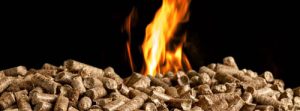 The bankruptcy filing in March by Maryland-based Enviva — the world’s largest maker of wood pellets from forest biomass — is rattling a European Union that relies heavily on biomass as a significant though contested renewable energy source.
The bankruptcy filing in March by Maryland-based Enviva — the world’s largest maker of wood pellets from forest biomass — is rattling a European Union that relies heavily on biomass as a significant though contested renewable energy source.
The bankruptcy is also invigorating U.S. forest advocates determined to keep the Biden Administration from using new renewable energy credits to bail out the flailing company. On March 21, officials from five federal agencies visited North and South Carolina to see an Enviva pellet-making plant firsthand and hear environmental justice complaints over the impacts it is having on low-income communities.
But the company faces immediate threats to its ongoing viability that transcend its $2.6 billion debt and negative community impacts, according to a former maintenance manager at two Enviva pellet-making plants in North Carolina and Virgina between 2020 and 2022, and an exclusive Mongabay source.
As many as eight of Enviva’s 10 pellet mills in the U.S. Southeast, he said, are in such poor condition that they are producing fewer pellets monthly at a much higher cost due to intractable and costly maintenance issues.
“There’s no way Enviva is coming out of Chapter 11,” the former employee told Mongabay, referring to a court-ordered reorganization process by which the firm has a set time to restructure its debt and begin paying back creditors. “Their manufacturing equipment is not fit for the service it’s required to deliver. Only two of its 10 plants (one in Florida, one in Georgia, neither built by Enviva) are hitting their maximum achievable targets for pellet production.” 04-02-24
In Chicago, One Neighborhood is Fighting Gentrification and Climate Change at the Same Time
The secret to success? Build affordable housing next to transit.
Christian Diaz hates a boxy, six-story brick building with blue and gray paneling in Logan Square, a rapidly gentrifying neighborhood on the northwest side of Chicago.
“It looks boring and uninspired,” said Diaz, the housing director at Palenque LSNA, formerly known as the Logan Square Neighborhood Association. “When people think gentrification, this is the building that comes to mind.”
The building is an example of what urban planners call Transit-Oriented Development, or TOD. The idea is that developing near transit leads to interconnected communities and fewer cars emitting carbon dioxide. Developers get incentives and neighbors get a walkable community. But Diaz said buildings like this — dense, tall developments catering to wealthy tenants — are accelerating gentrification in the once working-class, largely Latino neighborhood. Only three of the 60 units qualify as affordable housing.
“This building, thumbs down — 100 percent thumbs down,” Diaz said.
Instead, housing advocates like Diaz want TOD to evolve and become a tool to make Logan Square accessible for everyone — and to help reclaim it for people pushed out by gentrification. 04-05-24
As Amazon Eliminates Plastic Packaging Abroad, It’s Using Even More in the US
A new report finds Amazon has reduced plastic packaging the most in countries with stringent regulations.
In response to growing pressure to address the plastic pollution crisis, Amazon has been cutting down on plastic packaging. Last July, the company said it used 11.6 percent less plastic for all of its shipments globally in 2022, compared to 2021. Much of Amazon’s reductions took place in countries that have enacted — or threatened to enact — restrictions on certain types of plastic packaging. But the company’s progress may not extend to the U.S., which has not regulated plastic production on a federal level.
Amazon generated 208 million pounds of plastic packaging trash in the United States in 2022, about 10 percent more than the previous year, according to a new report from the nonprofit Oceana. This packaging includes Amazon’s ubiquitous blue-and-white mailers, as well as other pouches, bags, and plastic cushioning. If all of it were converted into plastic air pillows and laid end to end, Oceana estimates it would circle the Earth more than 200 times.
“The crisis is so significant that we need change now,” said Dana Miller, Oceana’s director of strategic initiatives and an author of the report.
Miller and her co-authors are calling on Amazon to stop using plastic packaging in the U.S., citing phaseouts in some of the company’s biggest overseas markets as evidence that such a transition is possible. Amazon has done “some pretty impressive things in Europe and India, but in the U.S. they are not making the same sort of commitments,” Miller added. “The company has made great progress, but it’s just not enough.”04-04-24
US Experienced Staggering Growth in Solar and Wind Power Over the Last Decade
Nearly a quarter of the nation’s grid now runs on renewables, bringing the country closer to its climate goals.
When you live far from the sprawling fields befitting utility-scale solar and wind farms, it’s easy to feel like clean energy isn’t coming online fast enough. But renewables have grown at a staggering rate since 2014 and now account for 22 percent of the nation’s electricity. Solar alone has grown an impressive eightfold in 10 years.
The sun and the wind have been the country’s fastest growing sources of energy over the past decade, according to a report the nonprofit Climate Central released Wednesday. Meanwhile, coal power has declined sharply, and methane use all but leveled off. With the Inflation Reduction Act poised to kick that growth curve higher with expanded tax credits for manufacturing and installing photovoltaic panels and wind turbines, the most optimistic projections suggest that the country is getting ever-closer to achieving its 2030 and 2035 clean energy goals.
“I think the rate at which renewables have been able to grow is just something that most people don’t recognize,” said Amanda Levin, director of policy analysis at the nonprofit National Resources Defense Council, who was not involved in preparing the report.
In the decade analyzed by Climate Central, solar went from generating less than half a percent of the nation’s electricity to producing nearly four percent. In that same period, wind grew from four percent to roughly 10. Once hydropower, geothermal, and biomass are accounted for, nearly a quarter of the nation’s grid was powered by renewable electricity in 2023, with the share only expected to rise thanks to the continued surge in solar. 04-03-24
The EPA Wanted to Clean Up Steel Mills. Then a Group of Rust Belt Senators Got Involved.
Steel towns will see some reductions in toxic pollution from new regulations — but not as much as they’d hoped.
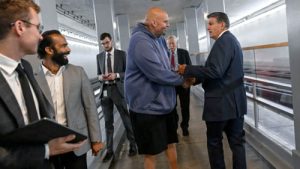
Senator John Fetterman has a quick exchange with Senator Joe Manchin in June 2023. Ricky Carioti / The Washington Post via Getty Images
In early March, a small group of Democratic senators from the Rust Belt sent President Joe Biden an urgent letter. They began by extolling the benefits of two of the Biden administration’s biggest achievements, the bipartisan infrastructure law and the Inflation Reduction Act, calling them “historic investments in our nation’s infrastructure” that will ring in a brighter future for American manufacturing. But there was something, they cautioned, that threatened to hamper this progress: the Environmental Protection Agency’s planned regulations for integrated iron and steel mills, proposed last July and nearing a court-ordered deadline.
“We are concerned that the EPA’s proposed integrated steel rules will do what foreign competitors have thus far been unable to do: deter and diminish continued American investment in improving our steel industry,” wrote the five senators, among them Joe Manchin of West Virginia and John Fetterman of Pennsylvania. They claimed the regulations would cost companies billions, enough to force widespread layoffs, despite the EPA’s estimate of $7.1 million in costs for the two companies, U.S. Steel and Cleveland-Cliffs, that own all 10 of the country’s steel mills.
Shortly after the senators sent off the letter, the EPA unveiled its final rule, the first time the agency has ever attempted to cut emissions from leaks and equipment malfunctions at steel mills. The EPA expects the new regulations will cut particle pollution by 473 tons every year. But the final rule is weaker than the one it proposed in 2023. Whereas the agency had originally planned to slash steel mills’ toxic emissions by 79 tons per year, a 15 percent decrease overall, the final version is expected to cut emissions by 64 tons each year. The EPA also dropped a proposed limit on the thickness of the smoke emanating from mills’ doors and roof vents. 04-02-24
In Texas, Ex-oil and Gas Workers Champion Geothermal Energy as a Replacement For Fossil-fueled Power Plants
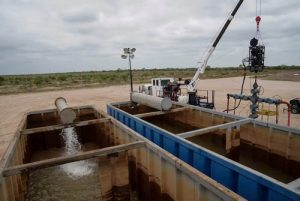
The pressurized water, which was pumped underground and later released to the surface through the well on the right, at the Starr County demonstration on March 22, 2023. Credit: Verónica Gabriela Cárdenas for The Texas Tribune
Texas has become an early hot spot for geothermal energy exploration as scores of former oil industry workers and executives are taking their knowledge to a new energy source.
STARR COUNTY — In 2009, on a plot of shrub-covered cattle land about 45 miles northwest of McAllen, Shell buried and abandoned a well it drilled to look for gas. The well turned out to be a dry hole. Vegetation grew back over the site.
In 2021, a Houston-based energy company run by former Shell employees came looking for it.
This company wasn’t drilling for oil or gas, though. Its engineers were looking for a place to experiment with their technology for producing geothermal energy, created by Earth’s underground heat.
A startup called Sage Geosystems leased the site. The company installed a wellhead and brought in a diesel-powered pump. They used fluid to create cracks in the rock deep below the surface, a technique similar to fracking for oil and gas.
One day last March, the crew pumped 20,000 barrels of water into the 2-mile-deep well. Hours later, an operator opened the well from a control room. Pipes above ground shook as the pressurized water gushed back up. The water spun small turbines, generating electricity. 03-26-24
The Last Coal-Fired Power Plants in New England Are to Close

The Schiller coal-fired power station in Portsmouth, N.H. In recent years, it had run only intermittently during peak periods.Credit…Gordon Chibroski/Portland Press Herald, via Getty Images
The company that owns the Merrimack and Schiller stations in New Hampshire plans to turn them into solar farms and battery storage for offshore wind.
The last two coal-fired power plants in New England are set to close by 2025 and 2028, ending the use of a fossil fuel that supplied electricity to the region for more than 50 years.
The decision to close the Merrimack and Schiller stations, both in New Hampshire, makes New England the second region in the country, after the Pacific Northwest, to stop burning coal.
After shutting down, the plants will be converted to solar farms and battery units that can store electricity generated from offshore wind turbines along the Atlantic Coast, the owner said.
Environmentalists waged a five-year legal battle against the New Hampshire plants, saying that they had discharged warm water from steam turbines into a nearby river without cooling it first to match the natural temperature.
In a settlement reached on Wednesday with the Sierra Club and the Conservation Law Foundation, Granite Shore Power, the owner of the plants, agreed that Schiller would not run after Dec. 31, 2025 and that Merrimack would cease operations no later than June 2028.
“This announcement is the culmination of years of persistence and dedication from so many people across New England,” said Gina McCarthy, a former national climate adviser to President Biden and former administrator of the Environmental Protection Agency during the Obama administration who is now a senior adviser at Bloomberg Philanthropies, which supports efforts to phase out coal. 03-28-24
Elizabeth Kolbert Wants Us to Rethink the Stories We Tell About Climate Change
In “H Is for Hope,” Kolbert explores the contradictions of a global problem, from A to Z.
Why does it feel like the world has made so much progress on addressing global warming, but also none at all?
In H Is for Hope: Climate Change from A to Z, Elizabeth Kolbert, a longtime environmental journalist, considers hard questions like this one. Using simple language, she explains that governments are passing climate-friendly laws, clean energy is expanding, companies are creating green technologies, and yet fossil fuel emissions are still, after all these years, rising.
Kolbert’s latest book, a primer brightened by Wesley Allsbrook’s colorful illustrations, is a quick, entertaining read. A is for Svante Arrhenius, a Swedish scientist who wanted to figure out what caused ice ages, landed on the idea of carbon dioxide, and built the world’s first climate model in 1894. Arrhenius imagined that a warmer world would be a happier one for humanity. B is for “blah, blah, blah,” the climate activist Greta Thunberg’s mocking summary of what three decades of global climate conferences have accomplished. C is for capitalism, one convincing explanation for why those conferences didn’t accomplish much.
Kolbert, a staff writer at The New Yorker, has written several books, most notably The Sixth Extinction, a Pulitzer-Prize winning account of Homo sapiens’ asteroid-level power to wipe out other species. In H Is for Hope, she grounds the abstract problem of climate change in concrete experiences. Kolbert ends up riding an exercise bike in a humid, 106-degree-Fahrenheit vault, monitored for an experiment. (“What is the future we’re creating actually going to feel like?”) She stares up at the blades of a 600-foot wind turbine off the coast of Rhode Island, and, after visiting a “green concrete” company in Montreal, takes a cinder block of the substance home as a souvenir.
Accidents Involving Toxic Vinyl Chloride Are Commonplace, a New Report Finds

Smoke rises from the derailed cargo train in East Palestine, Ohio, on Feb. 4, 2023. Credit: Dustin Franz/AFP via Getty Images
A year after a train derailment in East Palestine, Ohio, the study found vinyl chloride accidents have happened on average “once every five days since 2010.” An industry group says the chemical is safe and “makes modern life possible.”
The vinyl chloride industry made headlines across the country last winter when a train carrying the flammable, carcinogenic chemical derailed near the town of East Palestine, Ohio. News outlets published dystopian images of the smoke plume released by a controlled burn of the vinyl chloride cars, and thousands of people were evacuated from their homes.
Months later, when several environmental organizations, including the nonprofit Beyond Plastics, began advocating for the Environmental Protection Agency to consider banning vinyl chloride, the Vinyl Institute, an industry trade group, called their petition “a publicity stunt that irresponsibly ignores decades of credible science that shows VCM [vinyl chloride monomer] is safely and responsibly manufactured in the United States.”
In February, a blog post published by the Institute asserted that 95 percent of vinyl chloride manufactured in the U.S. is transported by pipeline to facilities on the same property, and that train accidents involving vinyl chloride are “exceedingly rare.”
The Institute insists that vinyl chloride and the product it’s most often used to make, polyvinyl chloride, or PVC, a plastic commonly found in pipes and flooring and known for its durability, are safe, and that protections for workers and the public have improved since the 1970s, when stricter regulations were passed. 03-26-24
In Utah, Climate Concerns Are Now Motivating Candidates
Would-be voters in the coal and oil state signal they’re increasingly alarmed by climate change.
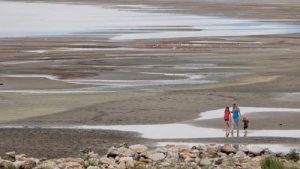
Visitors walk along a section of the Great Salt Lake that used to be underwater at the Great Salt Lake State Park on August 2, 2021 near Magna, Utah. Justin Sullivan / Getty Images
Driving on Interstate 215 south of Salt Lake City in late January, I couldn’t help but notice the bumper stickers on the pickup truck in front of me. One featured a rattlesnake and the classic motto “Don’t tread on me,” which dates to the Revolutionary War but has been co-opted by many right-wing ideologues. And the other featured a map of a shrinking lake and the words “Keep the Salt Lake Great,” the motto of a local environmental group focused on protecting Utah’s rivers and ecosystems.
Those dual views perfectly capture the ethos of Utah, a deep red state whose natural beauty is being threatened by more intense heat waves and extreme drought. A proud coal- and oil-producing state, it’s led by conservative lawmakers, and recent national surveys show it’s one of the most Republican states in the country. Back in 2010, the Utah Legislature even passed a resolution that essentially wrote climate change denial into state policy by urging the EPA to “cease its carbon dioxide reduction policies, programs, and regulations until climate data and global warming science are substantiated.”
But since then, Utah has been impacted by climate change more than most states — over the last 50 years, temperatures in the state have risen at about twice the global average, and it has faced worsening drought, wildfires, flash floods and extreme heat waves. The impact has been devastating on the health and well-being of residents, with decreasing productivity of farms and higher rates of respiratory disease and asthma, along with other heat-related diseases.
And climate change has seriously damaged one of the state’s natural wonders — that map on the truck driver’s bumper sticker reveals how climate change has shrunk the Great Salt Lake’s footprint by half in the last decades due to the reduced flow of mountain streams that feed the lake and higher demand for freshwater for new development and agriculture. 03-24-24
Florida is About to Erase Climate Change From Most of Its Laws
The state is spending big on adapting to sea level rise, but Republicans don’t want to name the cause.
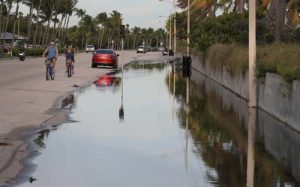
Water floods part of a street that runs near the Strait of Florida during the seasonal king tides in October 2019 in Key West, Florida. Researchers say the Florida Keys will see increased flooding as sea levels continue to rise. Joe Raedle / Getty Images
In Florida, the effects of climate change are hard to ignore, no matter your politics. It’s the hottest state — Miami spent a record 46 days above a heat index of 100 degrees last summer — and many homes and businesses are clustered along beachfront areas threatened by rising seas and hurricanes. The Republican-led legislature has responded with more than $640 million for resilience projects to adapt to coastal threats.
But the same politicians don’t seem ready to acknowledge the root cause of these problems. A bill awaiting signature from Governor Ron DeSantis, who dropped out of the Republican presidential race in January, would ban offshore wind energy, relax regulations on natural gas pipelines, and delete the majority of mentions of climate change from existing state laws.
“Florida is on the front lines of the warming climate crisis, and the fact that we’re going to erase that sends the wrong message,” said Yoca Arditi-Rocha, the executive director of the CLEO Institute, a climate education and advocacy nonprofit in Florida. “It sends the message, at least to me and to a good majority of Floridians, that this is not a priority for the state.”
As climate change has been swept into the country’s culture wars, it’s created a particularly sticky situation in Florida. Republicans associate “climate change” with Democrats — and see it as a pretext for pushing a progressive agenda — so they generally try to distance themselves from the issue. When a reporter asked DeSantis what he was doing to address the climate crisis in 2021, DeSantis dodged the question, replying, “We’re not doing any left-wing stuff.” In practice, this approach has consisted of trying to manage the effects of climate change while ignoring what’s behind them. 03-25-24
Emission Impossible
Here’s what happened when two climate reporters tried to ditch natural gas.
My wife and I live in a green, two-story colonial at the end of a cul-de-sac in Burlington, Vermont. Each spring, the front of our home is lined with lilacs, crocuses, and peonies. The backyard is thick with towering black locust trees. We occasionally spot a fox from our office windows, or toddlers from the neighborhood daycare trundling through the woods. It’s an alarmingly idyllic home, with one exception: It runs on natural gas.
The boiler, which heats our house and our water, burns it. So do the stove and the dryer and even the fireplace in the living room. Some 60 percent of American residences are similarly reliant on gas, the primary component of which is the potent greenhouse gas methane. This dependence on fossil fuels didn’t particularly faze us in the past. When we had to replace the furnace in our last place in late 2018, it was the easiest option. Same for the other appliances. At least it wasn’t oil, we told ourselves. It didn’t help that our contractors weren’t well-versed in alternatives and that our decisions were sometimes necessarily made in haste. When we did have time to explore switching to cleaner sources, the price tag often gave us pause. Can an induction stove really be that expensive?
Five years later, the landscape had shifted. The world was climbing dangerously toward 1.5 degrees Celsius (2.7 degrees Fahrenheit) of warming, and residential energy use accounted for one-sixth of all planet-heating emissions in the United States. We also wanted to start a family, and burning methane indoors can have potentially profound effects on human health. Then came the Inflation Reduction Act, which unleashed billions of federal dollars to help make cleaner technologies more ubiquitous and affordable than ever before. By early last year, we were ready to decarbonize. 03-21-24
Georgia Could Greenlight a Mine Near One of the South’s Last Wild Places

Charlene Carter, general manager at Okefenokee Pastimes Cabins and Campground, stands near maps with pins showing where people have visited from. (Alyssa Pointer for The Washington Post)
A planned titanium mine near the edge of the Okefenokee National Wildlife Refuge has drawn fierce resistance from people worried about the fate of the largest intact blackwater swamp in North America
Charlene Carter’s family has spent generations in and around the Okefenokee Swamp.
Its tannin-stained waters are practically part of her blood; its hundreds of bird species her eternal soundtrack; its maze of narrow canals, haunting cypress trees and ever-present alligators the backdrop of so many memories.
Carter now manages a campground and cafe at the edge of the roughly 640-square-mile Okefenokee National Wildlife Refuge, the largest intact blackwater swamp in North America. She longs for it to remain wild, pristine and protected — and counts herself among the outspoken opponents of a proposed titanium mine just outside its borders.
“I don’t care what they say,” said Carter, 39. “There’s a lot to lose.”
In this small corner of southeastern Georgia, a big fight is raging over the planned mine, which recently inched closer to approval.
The company behind the mine, Alabama-based Twin Pines Minerals, has promised that its investment will expand the local tax base and bring hundreds of good-paying jobs to an area where poverty runs deep. It insists its operations to extract titanium dioxide — widely used as a pigment in paints, sunscreens and an array of other products — will not leave a lasting scar on the land or threaten the beloved swamp. 03-17-24
Amazon Says Its Plastic Packaging Can Be Recycled. An Investigation Finds It Usually Isn’t.
Trackers placed in 93 bundles of Amazon packaging marked for “store drop-off” recycling showed many of them were buried or burned.
Feeling guilty about all those blue-and-white plastic Amazon bags piling up around the house? Fear not — they can be recycled! At least, that’s what the packaging says.
For years now, Amazon’s plastic bags, bubble-lined mailers, and air pillows have featured the ubiquitous “chasing arrows” recycling symbol along with the words “store drop-off.” The idea is simple: Since most curbside recycling programs don’t accept this type of plastic — it’s too expensive to process and can clog machines — consumers can instead leave it at retail stores across the country. From there, this plastic, known as “film,” will go to a specialized facility and be turned into new products.
The problem, however, is that the system doesn’t seem to be working.
An investigation published Tuesday by the nonprofits Environment America and U.S. Public Interest Research Group, or U.S. PIRG, suggests that only a small fraction of Amazon’s plastic packaging makes it to a material recovery facility, the term for operations that sort glass, metal, plastic, and other items for recycling. The packaging is much more likely to end up in a landfill, incinerator, export terminal, or in the hands of a company that downcycles plastic film into things like benches. 03-20-24
Most US Sandwich Baggies Contain Toxic PFAS ‘forever chemicals’, Analysis Says
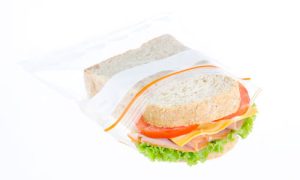
‘The more we look into PFAS, the more we know there is not a safe level,’ said Maricel Maffini with the Environmental Defense Fund. Photograph: Yongyut Khasawaong/Alamy
Testing commissioned by Mamavation blog found high levels of a marker of PFAS in nine of 11 baggies tested
Most of the nation’s plastic sandwich baggies contain toxic PFAS “forever chemicals”, an analysis suggests, raising questions about the products’ safety in the US.
Testing of 11 types of baggies made by major producers showed high levels of a marker of PFAS in nine.
The analysis, conducted by an Environmental Protection Agency-certified lab and commissioned by the Mamavation blog, is the latest to highlight the use of PFAS in the nation’s food packaging.
US Food and Drug Administration rules allow much higher levels of some individual PFAS compounds in plastic than what the testing found, but the FDA is working off “outdated science” and the baggies present a health threat, said Maricel Maffini, a researcher with the Environmental Defense Fund who tracks PFAS in food.
“The more we look into PFAS, the more we know there is not a safe level, and the [FDA’s limits] don’t correspond with the science and knowledge we have of these chemicals,” she said. 03-14-24
Proposed Bill Seeks to Ban Single-use Plastic Foam Products in US
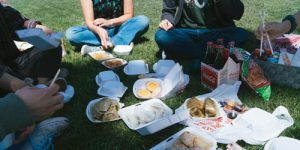 Expanded polystyrene foams are convenient packaging products, but they harm human and ecological health. Two US congresspeople proposed a national ban to address this issue.
Expanded polystyrene foams are convenient packaging products, but they harm human and ecological health. Two US congresspeople proposed a national ban to address this issue.
Takeout containers from restaurants on the side of the road. Discarded coffee cups floating in rivers. Packing peanuts shipped off to landfills.
Plastic foam products are ubiquitous. Now, a proposed congressional bill seeks to reduce this waste.
In December 2023, Democratic Sen. Chris Van Hollen and Democratic Rep. Lloyd Doggett jointly introduced the Farewell to Foam Act in both the Senate and House of Representatives. The bill would ban single-use expanded polystyrene food packaging products, coolers and loose-fill packaging products like packing peanuts by January 2026. The legislators cited plastic foam’s environmental and health harms as driving the bill. Though it’s uncertain whether it will move forward, experts and advocates say its introduction is a significant step toward establishing national single-use plastic bans, none of which currently exist in the U.S.
Expanded polystyrene, or EPS—erroneously referred to as Styrofoam, a trademarked material used in construction—is a fossil-fuel-derived plastic comprised of approximately 98% air and 2% plastic beads. This airiness makes EPS desirable for packaging: it insulates food, cushions products and costs little.
However, Van Hollen and Doggett claim the consequences of plastic foam pollution outweigh its convenience. “As trash clutters our waterways, roadsides, and greenspaces, foam doesn’t fully disintegrate. Instead, it ever so slowly degrades into microplastics that pollute our bodies and our planet,” the Texas Rep. said in a statement. 03-18-24
Inside the Right-wing Conspiracy to Thwart the Clean Energy Transition
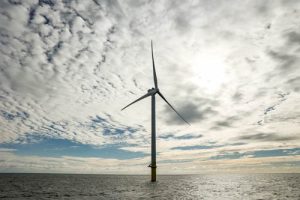
A wind turbine at the South Fork Wind Farm in the Atlantic Ocean off of Long Island, New York (Steve Pfost/Newsday RM/Getty Images)
Climate-science deniers, far-right think tanks and fossil fuel interests are spreading misinformation online and stoking local opposition to wind and solar projects.
Last July, a small group of rabble-rousers boarded a trio of powerboats, banners and bullhorns in hand. They were headed for the massive floating construction site of an offshore wind farm 35 miles from the eastern tip of Long Island, New York. As the boats motored through the swells, the self-styled activists broke into a chorus of pleas for the wind farm construction to cease — chants likely intended less for the still-faraway workers than for the camera there to capture footage. “Hear this message: We’re here to save the whales!” called out a man in a black polo shirt. “If you were a fossil fuel project, you would have been shut down long ago.”
That apparent conservation activist was, in fact, an infamous climate change disinformation artist: Marc Morano, who’s done more than perhaps any other person to manufacture doubt about global warming. From his perch at Climate Depot, the blog he’s run since 2009, Morano has elevated fake climate experts, encouraged the harassment of real climate scientists and promoted the myth of “global cooling.”
More recently, Morano has been talking about whales — specifically, the idea that the higher-than-usual number of dead ones washing ashore along the East Coast is the result of President Joe Biden’s push to develop 30 gigawatts of offshore wind power by the end of the decade. In fact, the spate of whale strandings began in January 2016, before most survey activity for ocean turbines had even begun. Federal agencies are still investigating “unusual mortality events” for three whale species, but regulators and academic researchers say there’s no evidence of a link to wind development. Since 2019, hundreds of gray whales have also washed up dead on the West Coast, where offshore wind development is only now getting underway. 03-15-24
Climate Change and Boat Strikes Are Killing Right Whales. Stronger Speed Limits Could Save Them.

Courtesy of Florida Fish and Wildlife Conservation Commission / National Oceanic and Atmospheric Administration permit #26919
Nearly a century after we almost hunted them to extinction, fewer than 360 right whales remain.
Amid a difficult year for North Atlantic right whales, a proposed rule to help protect them is one step closer to reality.
Earlier this month, a proposal to expand speed limits for boats — one of the leading causes of death for the endangered whales — took a key step forward: It’s now under review by the White House Office of Information and Regulatory Affairs, the last stage of federal review.
Fewer than 360 of the whales remain; only about 70 of them are females of reproductive age. Every individual whale is considered vital to the species’ survival, but since 2017 right whales have been experiencing what scientists call an “unusual mortality event,” during which 39 whales have died.
Human actions — including climate change — are killing them.
When the cause of a right whale’s death can be determined, it is most often a strike by a boat or entanglement in fishing gear. Three young whales have been found dead this year, two of them with wounds from boat strikes and the third entangled in gear. One of the whales killed by a boat was a calf just a few months old. 03-14-24
As Heat Becomes a National Threat, Who Will Be Protected?

Members of WeCount, an advocacy organization for South Florida’s immigrant workers and their families, rally for workplace heat protections in Miami in July 2023. Wilfredo Lee / AP Photo
Extreme heat affects everyone. But in Florida, the hottest state in the country, only one group is legally protected.
Laurie Giordano stood before a committee of Florida lawmakers in 2020, her hands trembling. She was there to tell the story of her son Zachary Martin, a 16-year-old football player who had died from heat stroke three years earlier.
“No mom should ever drop their kid off at football practice and then never hear their voice again,” she said, pleading for the passage of a bill that would provide heat-illness protections for high school athletes in Florida.
“Exertional heat stroke is 100 percent preventable and survivable, if we are prepared,” Giordano told the lawmakers. If her son were alive today, she said, he would be fighting for the bill’s protections, like rest and water breaks, which could have saved his life.
The legislators heeded her call and passed the Zachary Martin Act in her son’s honor just two months later. Since then, no student athlete has died from heat stroke in Florida, which now ranks highest in the country for its school sports safety provisions.
Two years after Martin’s death in Fort Myers, a Haitian farmworker in his 40s named Clovis Excellent died from heat stroke at a farm just north in Bradenton. He had been working for five hours, pulling stakes from tomato beds in temperatures exceeding 90 degrees Fahrenheit. 03-13-24
Pentagon Tries to Dodge PFAS Lawsuits Over a Product it Helped Invent
The U.S. government is seeking immunity from 27 lawsuits related to a toxic firefighting foam used on military bases.

Absorbent booms used to contain aqueous film-forming foam near a scene of a fire in Pennsylvania in 2019. Bastiaan Slabbers / NurPhoto
The United States government said it is immune to 27 lawsuits filed by local and state governments, businesses, and property owners over the military’s role in contaminating the country with deadly PFAS, also known as “forever chemicals.” The lawsuits are a small fraction of the thousands of cases brought by plaintiffs all over the country against a slew of entities that manufactured, sold, and used a product called aqueous film-forming foam, or AFFF — an ultra-effective fire suppressant that leached into drinking water supplies and soil across the U.S. over the course of decades.
The Department of Justice asked a U.S. district judge in South Carolina to dismiss the lawsuits last month, arguing that the government can’t be held liable for PFAS contamination. Lawyers for the plaintiffs called the move “misguided” and said that dismissing the lawsuits would extend an ongoing environmental catastrophe the Pentagon helped create.
Per- and polyfluoroalkyl substances, commonly known by the acronym PFAS (pronounced PEA’-fass), were invented by the chemical giant DuPont in the 1940s. DuPont trademarked the chemical as “Teflon,” which many Americans came to know and love for its use in nonstick cookware in the back half of the 20th century. 3M, another industry behemoth, quickly surpassed DuPont as the world’s largest manufacturer of PFAS, which have also been used in makeup, food packaging, clothing, and many industrial applications such as plastics, lubricants, and coolants.
Unfortunately, PFAS cause a host of health problems. PFAS have been linked to testicular, kidney and thyroid cancers; cardiovascular disease; and immune deficiencies. 03-12-24
New Lake Will Fuel Petrochemical Expansion on Texas Coast

Formosa Plastic Corp’s complex on Lavaca Bay in Point Comfort, Texas, pictured on June 7, 2023. Credit: Dylan Baddour/Inside Climate News
Blocked in Louisiana, Formosa Plastics looks to grow around Lavaca Bay instead. But it and other interested industrial plants are waiting for more water.
Texas regulators last month approved water rights for a new, 2,500-acre reservoir to meet the growing needs of chemical plants, refineries and other industries on the Gulf Coast.
A draft permit issued Feb. 23 by the Texas Commission on Environmental Quality authorizes the Lavaca-Navidad River Authority (LNRA) to divert up to 31 billion gallons per year from the Lavaca River. It would go into a reservoir proposed on property Formosa Plastics owns, about two miles east of its massive Point Comfort chemical complex, where the company has quietly pursued permits to expand in recent years since its Louisiana megaproject has been stalled by legal complaints.
The draft will undergo a 30-day period of public comment before being adopted.
It’s the first time in 50 years the small river authority has sought additional water rights, according to general manager Patrick Brzozowski. 03-08-24
Fossil Fuels and Petrochemicals May Be Making Us Sicker, Research Says
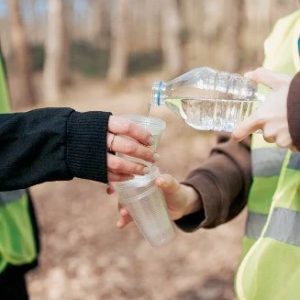
Petrochemicals can be found everywhere: in plastic water bottles, water filters, clothing, furniture, cooking ware and more. Credit: Unsplash+
“These chemicals may be invisible, but they are having visible impacts.”
HOUSTON – Fossil fuel combustion and plastic production has increased more than 15 times since the 1950s and resulting exposure is linked to rising rates of cancer, neurodevelopmental issues and infertility, according to a new report.
The new research, published in the New England Journal of Medicine, highlights the concerns of chemicals derived from fossil fuels, specifically petrochemicals. Many of these are endocrine-disrupting chemicals, meaning they can disrupt the body’s hormones. Petrochemicals can be found everywhere: in plastic water bottles, water filters, clothing, furniture, cooking ware and more.
The rise of these chemicals coincides with more illness: In the U.S., rates of neurodevelopmental disorders, diabetes, chronic respiratory disease and cancer have increased between 28% and 150% between 1990 and 2019, according to the report.
This report is evident of correlation in which two things tend to occur at the same time and appear to not be by chance. However, it is not the same as causation and other types of studies would be required to prove causation.
“These chemicals may be invisible, but they are having visible impacts,” Tracey Woodruff, UC San Francisco professor and director of the EaRTH Center and Program on Reproductive Health and the Environment and author of the paper, told Environmental Health News(EHN).
It’s not just the U.S. Over the past seven decades, chronic health conditions have been on the rise worldwide, coinciding with the rise in plastic production and endocrine-disrupting chemicals. These chemicals can dysregulate hormones in different ways: they can alter the way hormones are built or how they move in the body and interfere with hormone receptors. 03-08-24
How Climate Change Primed Texas to Burn
The state’s high plains get a month more fire weather now than they did in the 1970s.
The dry, dusty rangeland of the Texas Panhandle could not have been more perfectly suited to burn. Temperatures were 25 to 30 degrees Fahrenheit above normal. The air was dry, with humidity below 20 percent. And wind speeds were as high as 60 mph. Those hot and dry weather conditions worried meteorologists in the region, and their worst fears were realized February 26 when a spark set off a massive fire.
Over the past 10 days, five wildfires in the region have burned more than 1.2 million acres. The largest of them — dubbed the Smokehouse Creek Fire, for a creek near its origin — stretches across an area larger than Rhode Island. It’s the largest and most destructive wildfire in state history. Entire communities have had to evacuate. Two people have died. After more than a week of constant effort, crews have contained just 44 percent of the Smokehouse fire.
The fire has destroyed more than 500 homes, and thousands of cattle, horses, and goats have either succumbed to the fires or been euthanized. In light of the devastation, Governor Greg Abbott declared a state of emergency for 60 counties and requested additional resources from the federal government to battle the infernos.
“As Texas experiences the largest wildfire in the history of our state, we remain ready to deploy every available resource,” Abbott said at a press conference earlier this week. “The wildfires are not over yet, and until they are, it is essential that Texans in at-risk areas remain weather-aware to maintain the safety of themselves and their property.” 03-07-24
Industry Poisoned a Vibrant Black Neighborhood in Houston. Is a Buyout the Solution?
“Do you have to lose your history, your culture, or your identity in that process?”
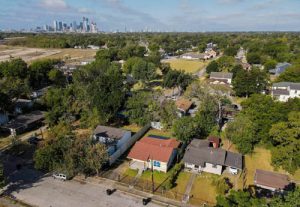
In Houston’s historically Black neighborhood known as the Fifth Ward, homes sit across from the former Southern Pacific rail yard. Jason Fochtman / Houston Chronicle via Getty Images
Leisa Glenn spent decades living in the Fifth Ward, a historically Black neighborhood in Houston, known for having one of the city’s best views of downtown. Every July 4th, Glenn, 65, and her neighbors would stream out of their houses into the summer heat and crowd onto front porches to watch the fireworks display.
She remembers the smell of the barbeque pit charring hot dogs and how neighbors would gather on every surface outside to watch: on top of cars, in folding chairs, and on porch steps.
“To look at the skyline at night, downtown, every night in different colors, and when they light it up — it’s like nothing you’ve ever seen before,” said Glenn.
Over the years, however, this crowd got smaller and smaller. Neighbors fell sick. Others moved away.
Buried beneath the Fifth Ward and its neighboring community, Kashmere Gardens, is an expansive toxic plume of creosote derived from coal tar. Historically, creosote has been used in the United States to preserve wood such as railroad ties and utility poles; it has also been linked to health issues such as lung irritation, stomach pain, rashes, liver and kidney problems, and even cancer, according to the Agency for Toxic Substances and Disease Registry and the Environmental Protection Agency. 03-06-24
Want Clean electricity? These Are the Overlooked Elected Officials That Get to Decide.
 As the Georgia Public Service Commission writes, “Very few governmental agencies have as much impact on peoples’ lives.”
As the Georgia Public Service Commission writes, “Very few governmental agencies have as much impact on peoples’ lives.”
On a Tuesday morning in January, college student Aurora Gray stepped up to the podium in a windowless room in Atlanta, around the corner from the state capitol building. In front of her sat a five-member panel of elected officials that oversees how and where nearly every Georgia resident gets their power.
“The generation of energy… using fossil fuels has become an existential threat to our safety due to the undisputed impacts of greenhouse gas emissions on our planet,” Gray told the commission. “We must act now, as later is way too late.”
More than a dozen other students sat behind her, awaiting their allotted three minutes in front of the Georgia Public Service Commission, or PSC. One after another, they called on the commission to reject a request from Georgia Power, the state’s largest utility, to add new natural gas capacity to the grid. Instead, they repeated at the podium, the company needs to expand renewable energy and take other steps to combat climate change. 03-05-24
There’s a Reason Exxon’s CEO Says Its Emissions Are Your Fault
Activist investors want the company to trim its biggest source of emissions. Exxon sees that as a threat.
When you fill up your tank and drive away from a gas station, is the resulting carbon pollution your fault? Or the fault of the oil giant that supplied the fuel?
Darren Woods, the CEO of Exxon Mobil, the largest publicly traded oil company in the world, has a clear answer. In a rare interview with the media last week, Woods explained that the “dirty secret” behind why the world wasn’t on track to zero out carbon emissions was that it was simply too expensive. In doing so, he subtly pinned the blame for the emissions created by burning oil and gas on his company’s customers.
“The people who are generating the emissions need to be aware of and pay the price for generating those emissions,” he told Fortune’s Leadership Next podcast. “That’s ultimately how you solve the problem.”
The emissions in question, created when oil and gas are actually burned, represent 80 to 95 percent of the worldwide emissions associated with oil companies. In energy wonk-land, these emissions are known as “Scope 3.” Three years ago, under pressure from activist investor groups, Exxon reluctantly revealed the vast scale of its own “Scope 3” emissions for the first time. The company estimated that the products it sold in 2019 resulted in 730 million metric tons of carbon dioxide. For reference, that’s 11 percent of what the entire United States emitted that year. 03-04-24








